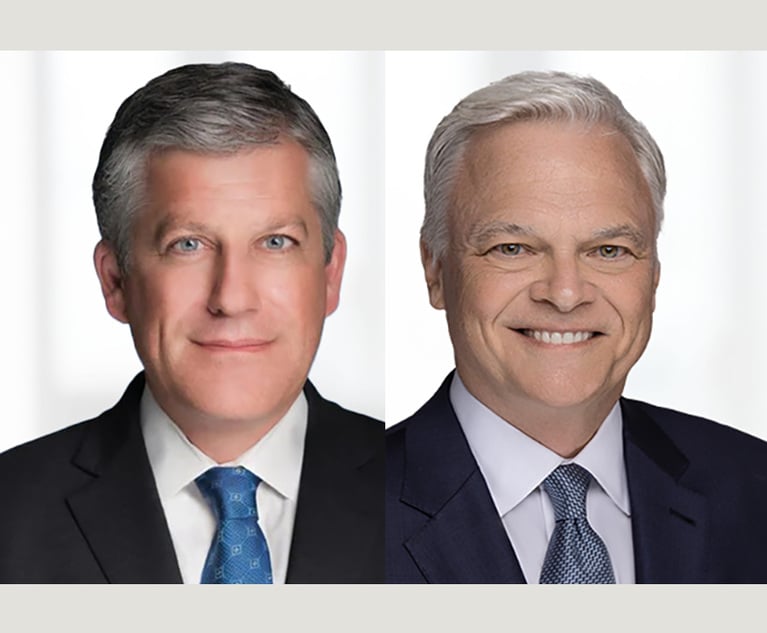 Nicole D. Galli, managing member of ND Galli Law.
Nicole D. Galli, managing member of ND Galli Law. AI and Legal Risk: A Perfect Storm
AI is here, and it is here to stay. And, of course, these tools are evolving at a rapid pace, presenting new opportunities for use and improving their utility on a nearly daily basis.
July 05, 2024 at 11:20 AM
9 minute read
It seems like every day there is a new opportunity to use AI in your work and free time—even when you do not need or want it. A few recent examples from my own desk (and likely yours) include Google search, which now has a new "AI Overview" feature that seems to pop up with every search; Microsoft Co-Pilot, which my Office 365 software suggests I use every time I log on; Adobe, with its "AI Assistant" (still figuring out what its purpose is—and if I can disable it!) and its own generative AI (GenAI) tool (which can be shut off); Zoom "AI Companion"—its proprietary competitor to Otter.ai; and Facebook with its new "Ask Meta AI anything" (haven't been able to shut that off either). If you use a computer—or phone (iPhone, I'm looking at you!) —for anything, you can no longer "ignore" AI and assume it does not apply to you. In short, AI is here, and it is here to stay. And, of course, these tools are evolving at a rapid pace, presenting new opportunities for use and improving their utility on a nearly daily basis.
Despite their ubiquity and advertised benefits, as all lawyers should know by now, these tools also present tremendous risks. Among the most paramount concerns are questions about AI's validity and reliability (or more precisely, invalidity and unreliability—e.g., "hallucinations"), as well as security (i.e., implicating both privacy and trade secret law). These tools also present many other opportunities to run afoul (or at least run into gray areas) of various areas of the law such as discrimination occasioned by bias (allegedly, possibly accidentally) built into the AI tools. Straddling the realms of IP, privacy, and even national security there are, of course, "deepfakes" raising, among other things, name, image and likeness implications. And last, but not least, there are the much-discussed potential copyright infringement issues arising from the use of materials subject to copyright in training materials for generative AI tools, and as well as the continuing uncertainty around the extent to which AI-assisted inventions or creations can be protected via patent or copyright.
This content has been archived. It is available through our partners, LexisNexis® and Bloomberg Law.
To view this content, please continue to their sites.
Not a Lexis Subscriber?
Subscribe Now
Not a Bloomberg Law Subscriber?
Subscribe Now
NOT FOR REPRINT
© 2025 ALM Global, LLC, All Rights Reserved. Request academic re-use from www.copyright.com. All other uses, submit a request to [email protected]. For more information visit Asset & Logo Licensing.
You Might Like
View All
'Taking the Best' of Both Firms, Ballard Spahr and Lane Powell Officially Merge
6 minute read

Trending Stories
- 1The New Rules of AI: Part 2—Designing and Implementing Governance Programs
- 2Plaintiffs Attorneys Awarded $113K on $1 Judgment in Noise Ordinance Dispute
- 3As Litigation Finance Industry Matures, Links With Insurance Tighten
- 4The Gold Standard: Remembering Judge Jeffrey Alker Meyer
- 5NJ Supreme Court Clarifies Affidavit of Merit Requirement for Doctor With Dual Specialties
Who Got The Work
J. Brugh Lower of Gibbons has entered an appearance for industrial equipment supplier Devco Corporation in a pending trademark infringement lawsuit. The suit, accusing the defendant of selling knock-off Graco products, was filed Dec. 18 in New Jersey District Court by Rivkin Radler on behalf of Graco Inc. and Graco Minnesota. The case, assigned to U.S. District Judge Zahid N. Quraishi, is 3:24-cv-11294, Graco Inc. et al v. Devco Corporation.
Who Got The Work
Rebecca Maller-Stein and Kent A. Yalowitz of Arnold & Porter Kaye Scholer have entered their appearances for Hanaco Venture Capital and its executives, Lior Prosor and David Frankel, in a pending securities lawsuit. The action, filed on Dec. 24 in New York Southern District Court by Zell, Aron & Co. on behalf of Goldeneye Advisors, accuses the defendants of negligently and fraudulently managing the plaintiff's $1 million investment. The case, assigned to U.S. District Judge Vernon S. Broderick, is 1:24-cv-09918, Goldeneye Advisors, LLC v. Hanaco Venture Capital, Ltd. et al.
Who Got The Work
Attorneys from A&O Shearman has stepped in as defense counsel for Toronto-Dominion Bank and other defendants in a pending securities class action. The suit, filed Dec. 11 in New York Southern District Court by Bleichmar Fonti & Auld, accuses the defendants of concealing the bank's 'pervasive' deficiencies in regards to its compliance with the Bank Secrecy Act and the quality of its anti-money laundering controls. The case, assigned to U.S. District Judge Arun Subramanian, is 1:24-cv-09445, Gonzalez v. The Toronto-Dominion Bank et al.
Who Got The Work
Crown Castle International, a Pennsylvania company providing shared communications infrastructure, has turned to Luke D. Wolf of Gordon Rees Scully Mansukhani to fend off a pending breach-of-contract lawsuit. The court action, filed Nov. 25 in Michigan Eastern District Court by Hooper Hathaway PC on behalf of The Town Residences LLC, accuses Crown Castle of failing to transfer approximately $30,000 in utility payments from T-Mobile in breach of a roof-top lease and assignment agreement. The case, assigned to U.S. District Judge Susan K. Declercq, is 2:24-cv-13131, The Town Residences LLC v. T-Mobile US, Inc. et al.
Who Got The Work
Wilfred P. Coronato and Daniel M. Schwartz of McCarter & English have stepped in as defense counsel to Electrolux Home Products Inc. in a pending product liability lawsuit. The court action, filed Nov. 26 in New York Eastern District Court by Poulos Lopiccolo PC and Nagel Rice LLP on behalf of David Stern, alleges that the defendant's refrigerators’ drawers and shelving repeatedly break and fall apart within months after purchase. The case, assigned to U.S. District Judge Joan M. Azrack, is 2:24-cv-08204, Stern v. Electrolux Home Products, Inc.






